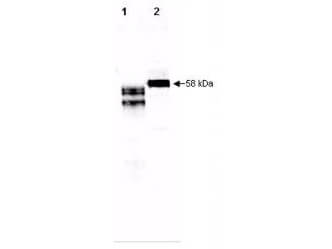Anti-Fetuin (2-HS Glycoprotein) (GOAT) Antibody
Fetuin Antibody
- SPECIFICATION
- CITATIONS
- PROTOCOLS
- BACKGROUND

| Host | Goat |
|---|---|
| Conjugate | Unconjugated |
| Target Species | Human |
| Reactivity | Human |
| Clonality | Polyclonal |
Application
| WB, E, I, LCI |
| Application Note | This purified polyclonal antibody has been tested by western blot. Although not tested, this antibody is likely functional in ELISA, immunohistochemistry, and immunoprecipitation. A doublet band or slightly lower molecular weight band (see image) may be visible by western blot due to proteolytic processing, variable glycosylation and/or phosphorylation. Proteolytic processing may include the removal of a 40 amino acid residue bridging peptide from the A and B chains of fetuin in vivo. |
| Physical State | Lyophilized |
| Buffer | 0.02 M Potassium Phosphate, 0.15 M Sodium Chloride, pH 7.2 |
| Immunogen | This purified antibody was prepared from rabbit serum after repeated immunizations with a recombinant human fetuin (a2-HS glycoprotein) processed to remove a 40 amino acid residue bridging peptide resulting in the mature form of the protein. |
| Reconstitution Volume | 500 µL |
| Reconstitution Buffer | Restore with deionized water (or equivalent) |
| Preservative | 0.01% (w/v) Sodium Azide |
| Gene ID | 197 |
|---|---|
| Other Names | 197 |
| Purity | This product is an IgG fraction antibody purified from monospecific antiserum by a multi-step process which includes delipidation, salt fractionation and ion exchange chromatography followed by extensive dialysis against the buffer stated above. Assay by immunoelectrophoresis resulted in a single precipitin arc against anti-Goat Serum. |
| Storage Condition | Store vial at 4° C prior to restoration. For extended storage aliquot contents and freeze at -20° C or below. Avoid cycles of freezing and thawing. Centrifuge product if not completely clear after standing at room temperature. This product is stable for several weeks at 4° C as an undiluted liquid. Dilute only prior to immediate use. |
| Precautions Note | This product is for research use only and is not intended for therapeutic or diagnostic applications. |
| Name | AHSG |
|---|---|
| Synonyms | FETUA |
| Function | Promotes endocytosis, possesses opsonic properties and influences the mineral phase of bone. Shows affinity for calcium and barium ions. |
| Cellular Location | Secreted. |
| Tissue Location | Synthesized in liver and selectively concentrated in bone matrix. Secreted in plasma. It is also found in dentin in much higher quantities than other plasma proteins |

Thousands of laboratories across the world have published research that depended on the performance of antibodies from Abcepta to advance their research. Check out links to articles that cite our products in major peer-reviewed journals, organized by research category.
info@abcepta.com, and receive a free "I Love Antibodies" mug.
Provided below are standard protocols that you may find useful for product applications.
Background
Human fetuin (2-Heremans-Schmid-glycoprotein or α2-HS-glycoprotein) is a major plasma glycoprotein predominantly synthesized in the liver. Human fetuin is named after its bovine homolog. Fetuins are found in most mammals. Human fetuin is a negative acute-phase protein; normal circulating levels in adults (300–600 µg/ml) fall significantly (30–50%) during injury and infection. The biological role of fetuin is unknown, although it has been implicated as an immunomodulator that can participate in stimulation of bacterial phagocytosis by neutrophils and promotion of endocytosis by mouse macrophages. Hepatocytes are the principal cell source of circulating fetuin, but it also is expressed by monocyte/macrophages. Fetuins occur in large amounts in blood and cerebrospinal fluid and accumulate to high concentrations in calcified bone. The fetuin promoter region has several potential interleukin 6-responsive elements, and its synthesis is down-regulated during injury and inflammation. Fetuin is an acidic glycoprotein with three N-linked and three O-linked oligosaccharide chains, whose terminal sugar residues are rich in sialic acid (N-acetylneuraminic acid), contributing to its net negative charge. A role for fetuin as a carrier of bioactive molecules has been proposed based on observations that it binds and carries Ca2+ ion. Fetuin is implicated in bone remodeling, immune function and may play a role in tumor progression of certain cell types.
If you have used an Abcepta product and would like to share how it has performed, please click on the "Submit Review" button and provide the requested information. Our staff will examine and post your review and contact you if needed.
If you have any additional inquiries please email technical services at tech@abcepta.com.













 Foundational characteristics of cancer include proliferation, angiogenesis, migration, evasion of apoptosis, and cellular immortality. Find key markers for these cellular processes and antibodies to detect them.
Foundational characteristics of cancer include proliferation, angiogenesis, migration, evasion of apoptosis, and cellular immortality. Find key markers for these cellular processes and antibodies to detect them. The SUMOplot™ Analysis Program predicts and scores sumoylation sites in your protein. SUMOylation is a post-translational modification involved in various cellular processes, such as nuclear-cytosolic transport, transcriptional regulation, apoptosis, protein stability, response to stress, and progression through the cell cycle.
The SUMOplot™ Analysis Program predicts and scores sumoylation sites in your protein. SUMOylation is a post-translational modification involved in various cellular processes, such as nuclear-cytosolic transport, transcriptional regulation, apoptosis, protein stability, response to stress, and progression through the cell cycle. The Autophagy Receptor Motif Plotter predicts and scores autophagy receptor binding sites in your protein. Identifying proteins connected to this pathway is critical to understanding the role of autophagy in physiological as well as pathological processes such as development, differentiation, neurodegenerative diseases, stress, infection, and cancer.
The Autophagy Receptor Motif Plotter predicts and scores autophagy receptor binding sites in your protein. Identifying proteins connected to this pathway is critical to understanding the role of autophagy in physiological as well as pathological processes such as development, differentiation, neurodegenerative diseases, stress, infection, and cancer.


